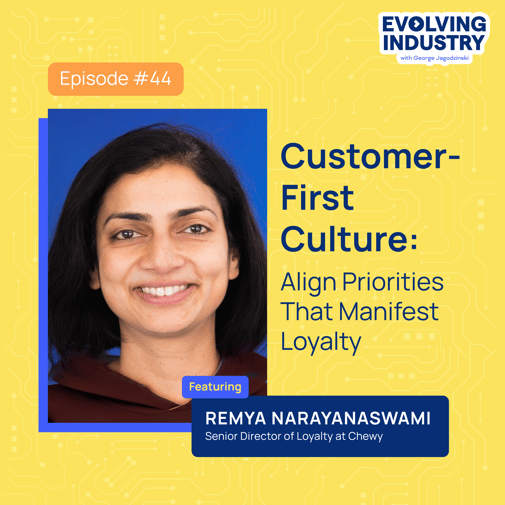Evolving Industry
Pet supply retailer Chewy is renowned for a customer-first culture that has set the standard for brand loyalty.
So how did they do it?
Remya Narayanaswami, Chewy’s Senior Director of Loyalty, told us it starts with having leadership who can clarify an enterprise-wide goal.
Remya talked with us about:
- Creating product and tech solutions around customer needs
- Building a digital experience from a blank canvas
- Filtering real contributors from the well-intentioned for new projects
A Customer-First Culture That Checks Egos at the Door
Many organizations struggle to find an identity as they try to cultivate product-led or technology-led cultures.
As generative AI continues to take the world by storm, this wave of historical innovation will only add more nuance to these working environments.
But Remya told us that her time with Amazon and Chewy has shown her the power of building product and tech strategies around a customer-first culture.
“Everybody, I think, should rephrase themselves as a customer-first culture rather than a business-led or technology-led culture.”
That’s how companies like Chewy built a foundation of brand loyalty that consistently brings customers back to their digital storefronts.
“Start with the customer. Always identify what the customer’s problem is [and] identify what your solutions are,” Remya said. “Start working backward from the customer and [determine] whether it is technology that’s going to solve the problem or smart pricing.”
Yet large companies like Chewy have many different departments pushing different priorities. So how does leadership keep everyone on mission?
“Teams can develop mechanisms to help understand and make prioritization trade-offs if there is clarity from leadership on the enterprise-wide goal,” she said.
That clarity is essential to ensuring everyone works together for the greater good of the organization.
“Collaborate with a growth mindset and without ego,” she said. “Once you get to a certain level, there is no individual, group, or team that can solve the problem. It has to be multiple functions coming together.”
Innovation From the Ground Up
Remya has led the development of several groundbreaking initiatives, like Amazon’s Treasure Truck program.
When asked about building these digital experiences from a blank canvas, she said it’s typical — even warranted — for the customer-first mindset to take a backseat temporarily.
“I would say it's a honeymoon period where all teams actually come together to solve that one problem because you really need a product or a service to get out the door to get your first set of customers.”
Often, that means doing just enough to catch the interest of a few troubleshooters before pushing your product or service to the masses.
“The reason it’s called ‘minimum viable product’ is you only want to build enough to get those early adopters,” Remya said. “Once you get those early adopters, you can actually learn from your customers and then decide what you build on top of that.”
This early stage is critical to choosing a clear direction for a new product or service because customers and team members will have plenty to say.
“You always have to remember that people, the audience who is reviewing what you want to do, have their own perspectives,” Remya said. “Typically, at this stage, you don’t have a lot of data to go off of, so there’s a lot of judgment.”
She acknowledged that the most challenging part of the process is getting buy-in from everyone involved. However, the hard part is over once the objective is clear.
“Once you know what you want to build, then [everyone’s] going to come together because, at that point, there is clarity in what you need to do, and it’s just a matter of execution.”
When Good Intentions Get in the Way of Progress
Another early hurdle in leading exciting new projects is filtering real contributors from interested parties who may not be a good fit.
Remya believes that the process starts with just being honest with every stakeholder.
“I'm a big believer in transparent communication,” Remya said. “We talked about earning trust or losing the trust of customers. But it's equally important to make sure you earn the trust of your internal partners and your collaborators and your team members.”
Of course, not everyone is on a “need to know” basis during every stage of a new project. So how does Remya ensure that everyone’s concerns are heard?
“Either make sure you proactively address them or at least let them know, ‘Hey, I heard you. I’m going to make sure that when it’s the right time for you to know what this program or project is about, that your feedback’s already been incorporated.’”
These discussions aren’t simply about easing peoples’ fears. Remya suggested you may pick up some valuable insights, as well.
“That entire conversation may not be directly applicable to what you’re trying to accomplish, but there are always nuggets,” she said. “Those are very important because there is no other way to get that information unless you’re having the conversation.”
Ultimately, it’s on leaders to delegate to the right people for the job.
“I always believe that everyone has the best intentions,” she said. “It’s on you to understand what their inputs are.”
Craving more? You can find this interview and many more by subscribing to Evolving Industry on Apple Podcasts, on Spotify, or here.
